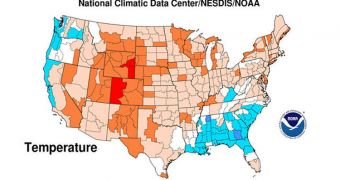According to the results of a new State of the Climate report, published by the US National Oceanic and Atmospheric Administration's (NOAA) National Climatic Data Center (NCDC), the summer of 2012 was the third warmest ever recorded since measurements began, in 1895.
The month of August was the 16th warmest on record, the same analysis indicates. Average temperatures over the contiguous US were 74.4 degrees Fahrenheit (23.5ºC), which is around 1.6 degrees Fahrenheit (0.9ºC) above the long-term average.
Statistics show that the month of July was the warmest ever recorded. At the same time, data show that the month of June was also warmer than the average. All these factors combined to create the third warmest summer in more than 110 years.
Average temperatures for the summer reached 74.4ºF (23.5ºC), a value around 2.3ºF (1.3ºC) higher than the long-term average. The only times when summers were hotter than this one were in 2011 (74.5ºF or 23.6ºC) and 1936 (74.5ºF or 23.6ºC).
“Drier-than-average conditions stretched from the Pacific Northwest, through the Rockies, and into the Upper Midwest. Nebraska, Washington and Wyoming each had their driest August on record. Colorado, Idaho and Oregon each had a top ten dry August,” the report indicates.
“Hurricane Isaac made landfall along Louisiana's coast on August 28th with maximum sustained winds of 80 [miles, or 128.7 kilometers], per hour. [It] provided some relief to drought-stricken areas of the Midwest,” the document adds.
The only areas that were cooler than average were found in the Southeast and the Northwest. However, only a limited number of regions displayed a cooling trend. On the other hand, a whopping 63 percent of the country's surface continues to be plagued by drought.
“The warm and dry conditions across much of the West were associated with another month of ideal wildfire conditions. Over 3.6 million acres burned nationwide, mostly across the West. The acreage burned was nearly twice the August average and the most for the month in the 12-year period record,” the report indicates.
Climatologists have been drawing attention to the fact that droughts and high temperatures will become increasingly common for many years, but there still appears to be no political will to stop global warming and climate change.

 14 DAY TRIAL //
14 DAY TRIAL //